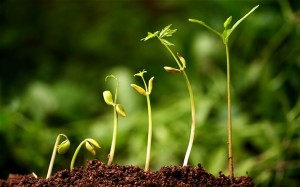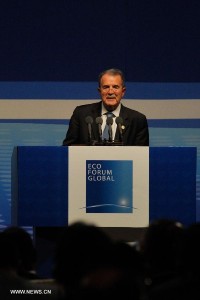Economic growth and environment: the challenge is achieveing both goals at the same time
 Building A Global Eco-Civilization
Building A Global Eco-Civilization
Green Transformation and Transition – green industry, green urbanization and green consumption lead sustainable development
Speech by Romano Prodi to “Eco Global Forum Annual Conference” held in Guiyang July 20th, 2013
Despite the recent economic crisis, in the past decades the world has experienced an extraordinary economic growth which has reduced poverty at the global level. However, not only such a growth has been uneven among countries and often within the same country, but it has been achieved at a high price: environmental pollution and natural resource depletion.
In light of the future population growth, the past and present development strategies not only can further damage the environment, but they can also jeopardize economic growth, sustainable development, and human security.
World population is expected to increase from 7 billion today to over 9 billion in 2050 and the individual consumption of these 9 billion people will heavily increase.
Such a growth will increase pressures on a variety of interconnected areas, such as urbanization, agriculture, food and water security, energy and biodiversity.
Let me quote a few data, mainly taken from the OECD Environmental Outlook to 2050, and discuss some of the implications of the population growth that will happen in the coming decades.
1)Firstly, global water demand is set to raise by some 55%. The main increases in water demand will be in the emerging economies and developing countries. In particular, freshwater availability will be under stress, with more than 2 billion people living in regions under severe water shortage or with equally severe water pollution. No need to stress how important is the water challenge even in China.
2)Secondly, water shortage will translate into food scarcity. Demographic growth implies more demand for food for human beings and for foodstuffs to feed livestock, with less people working in agriculture to produce them. While human beings drink only two to four liters of water a day, it takes 2,000 liters of water to produce food for an individual daily consumption.
3)Thirdly, in relation to urbanization the picture is clear, too: cities are likely to absorb most of the increase in the world population. By 2050, nearly 70% of the world population will be living in urban areas. And, once again, China is in the forefront of this transformation. In fact, China can be seen as a laboratory where the world’s challenges but also the strategies to overcome them are in full play.
This massive “movement” from the countryside to cities will have significant and challenging consequences.
Because the world energy mix in 2050 will not be very different from the present, with the share of fossil energy at about 85%, air pollution will be the world’s top environmental cause of premature mortality, side by side with polluted water and poor sanitation.
Forest areas are projected to shrink by 13% and biodiversity is set to decrease by a further 10%.
A world economy four times larger than today will need at least 80% more energy in 2050 without new policies. The BRICs are forecasted to become major energy users, increasing their reliance on fossil fuels.
In sum, without a common shared effort the world will be more populated, with less drinkable water, less food, and with more polluted cities.
Other potentially negative dynamics are contributing to further aggravate this already worrisome situation, like overcultivation and overgrazing, growing biomass production for fuel, and climate change with rising temperatures.
Moreover, if the international community does not make a significant step towards a green economy, the food crisis is likely to reoccur. The FAO has correctly warned against a “false sense of security” in the food area. We must therefore put an end to the competition between energy and food.
Obviously, this is a bleak picture. But we cannot avoid to take it into consideration if we want to avoid the materialization of its negative consequences.
 The future challenge is to achieve economic growth while increasing environmental quality. The challenge is not to find a balance between these two goals, but exactly to find ways to achieve both goals at the same time.
The future challenge is to achieve economic growth while increasing environmental quality. The challenge is not to find a balance between these two goals, but exactly to find ways to achieve both goals at the same time.
In order to respond to this challenge we need first of all to achieve a rise in productivity of the land already farmed today, by employing the available techniques that improve water use efficiency and reduce the energy needed for cultivation.
Thus, a new global policy for irrigation should be employed, using the best water saving technologies. A stronger and wider approach in relation to the use of the water of the most important international river basins is also crucial, if we want to avoid new wars and conflicts.
We face therefore many big and difficult challenges.
However, I would like to conclude with a note of optimism.
While a few years ago, green economy was a matter for specialists and a very small reality, now green economy is an integral part of the overall development strategy. China and the world share the same common dream: to the fight against the corruption of our life and of our environment, the effort to defeat all the forms of hubris.
The China dream and the other national dreams are not incompatible, on the contrary, they can be complementary. The parallel dreams must grow together working side by side with Europe, United States and all other world countries China has a great opportunity to reinterpret its traditional wisdom through the classical notion of harmony.
Not an easy challenge if we remember that when Confucius developed his thoughts on harmony, the world population was around 100 million people.
Another great historical task for China is to take advantage of its leadership in solar and removable energies.
As I learned in my role of United Nations Special Envoy for Sahel it will be a great progress for mankind to help the populations of the poorest regions of the world to enter into the modernity directly using the most advanced instruments of renovable energy, saving most of the large costs of long distant trasmissions.
Luckily there is today a widespread consensus on the fact that environmental security is not simply necessary for water and food security, but it is the pillar for long term sustainable development.
The current interest and the success of the green economy has shown that there is not always a tradeoff between growth and a clean environment.
A key step towards green economy is to build those necessary legal and economic conditions that make environmentally friendly investments profitable.
This is a lesson that China has learnt. Indeed the Chinese stimulus package, organized to counteract the economic crisis, was centred around the concept of “green growth”.
Unfortunately, many country regulations favor the so-called “brown economy”, which relies heavily on fossil fuels, resource overexploitation, and environmental pollution.
Let me conclude by making clear that decisions and policies that invest in the green economy not only contribute to create a safe environment, but they might also create incentives to move the economy on a different path of growth based on human capital and knowledge.
And there is no need to tell you that human capital and knowledge are the two most important social and economic investments that any country can make on its future growth.






















